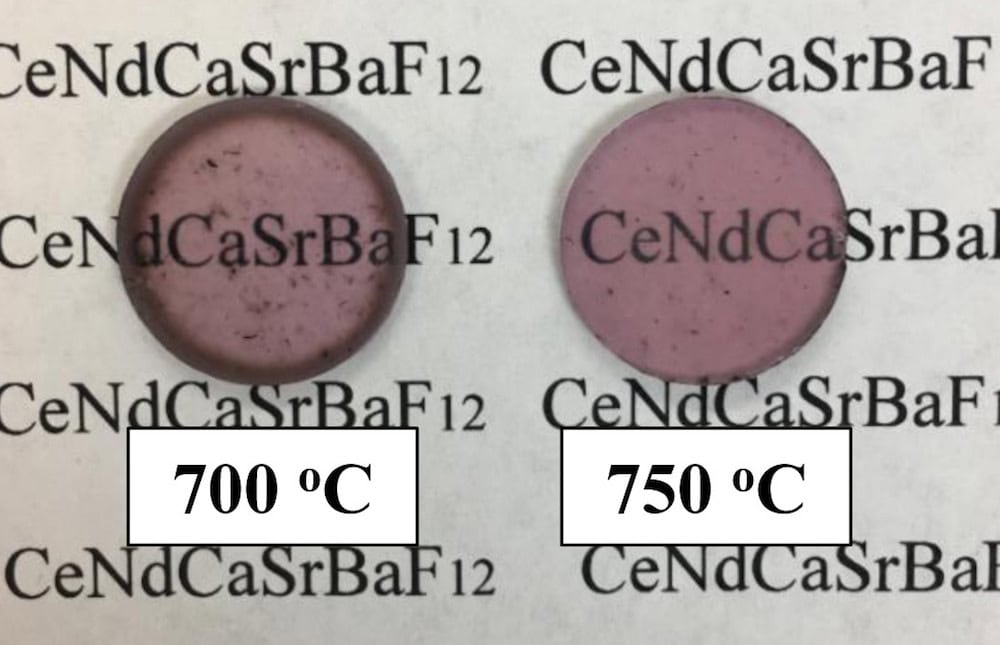
[Image above] High-entropy fluoride-based transparent ceramics sintered at 700°C and 750°C by vacuum hot pressing. Credit: Chen and Wu, Journal of the American Ceramic Society
More isn’t always better. But in the case of high-entropy alloys (HEAs), more elements are the key to their success.
HEAs are defined as solid solutions that consist of five or more elements of approximately equimolar composition. A solid solution is a multicomponent system in which all components remain in a single homogeneous phase. In the case of HEAs, elements remain in one phase because the structure is “entropy stabilized,” that is, HEA structure is stable due to entropy (a measure of disorder).
(The existence of disorder favors formation of a new simple phase. More elements increase entropy and thus increase chance of simple phase formation in HEAs.)
Yeh et al. and Cantor et al. published the first reports on HEAs in 2004. In 2014, Murty et al. published a book on the current state of HEA research and suggested an analogous effect could be expected in ceramic and polymeric materials as well. In 2015, Rost et al. demonstrated the viability of creating high-entropy ceramics when they fabricated an entropy-stabilized oxide solid solution.
In studies, high-entropy materials exhibit unique mechanical (strength, hardness, ductility, wear resistance), physical (magnetic, conductivity), and chemical (corrosion, oxidation, wear resistance) properties. However, optical properties of high-entropy materials have not been explored and studied fundamentally yet. A recent paper published in the Journal of the American Ceramic Society begins to fill this knowledge gap.
Xianqiang Chen and Yiquan Wu, post-doc and professor, respectively, at Alfred University, chose to investigate high-entropy fluoride-based ceramics due to the advantages fluoride ceramics offer to optical applications, including nonhygroscopic nature (does not readily absorb/retain moisture), relative ease of machining and polishing, high thermal conductivity, and high doping concentration. Already, “fluoride materials see application in such areas as lasers, scintillators, windows, and ultraviolet (UV) and vacuum ultraviolet (VUV) lenses,” they add in the paper.
In an email, Wu says that single-phase fluoride ceramics have been investigated before but not high-entropy fluoride ceramics, making this study the first of its kind.
To create the first high-entropy fluoride transparent ceramic, Chen and Wu synthesized CeNdCaSrBaF12 nanopowders via a coprecipitation method using commercially sourced products. The resulting powder was then consolidated under a vacuum hot-pressing method to reach full densification.
To measure optical properties, the researchers used a UV‐visible spectrophotometer to measure UV-visible in-line transmittance over wavelengths of 200–1000 nm, and a Fourier-transform infrared spectrometer to measure infrared transmittance over wavelengths of 1.4–15 μm. Photoluminescence excitation and emission spectra measurements were conducted at room temperature using a homemade spectrometer and an emission monochromator.

A) In-line transmittances of the fluoride-based transparent ceramics (thickness = 1.4 mm) sintered at 700°C and 750°C; B) FTIR spectrum of fluoride-based transparent ceramics sintered at 750°C. Credit: Chen and Wu, Journal of the American Ceramic Society
“The work shows that the CeNdCaSrBaF12 transparent ceramics possess broad excitation bands in the visible and NIR [near infrared] regions, which are advantageous for its application as a laser material and will reduce its dependency on pumping wavelengths which, in turn, reduce the need for temperature control of the laser diodes,” Wu says. “This [property] will make the high-entropy laser ceramic an attractive candidate for developing miniaturized laser devices.”
In the future, Wu says they plan to investigate the atomic level microstructures of high-entropy laser ceramics to understand the local atom environments of dopant and host materials. Additionally, optical, thermal, and mechanical properties of the high-entropy transparent ceramics will be studied to explore any unique functions for additional optical and photonic applications.
The paper, published in Journal of the American Ceramic Society, is “High-entropy transparent fluoride laser ceramics” (DOI: 10.1111/jace.16842).
Author
Lisa McDonald
CTT Categories
- Basic Science
- Optics


